
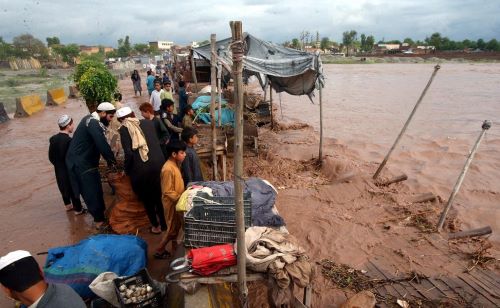
The suffering caused by the climate crisis is a political choice.

By Joe Ware
Senior Climate Journalist
Christian Aid

By Oliver Pearce
Chief of Policy
Christian Aid
Foreword by Patrick Watt
2024 has been a year where climate breakdown has been on display across our world. Terrible storms, flooding in desert regions, and droughts along the Amazon River. The climate crisis is truly turning the world upside down.
The scientific evidence of the lethal toll that burning fossil fuels is taking on our fellow humans and the planet at large is incontrovertible. This will likely be the hottest year ever recorded, breaking last year’s previous record.
The data is now also showing that climate change is doubling the likelihood of many extreme weather events like floods and tropical cyclones and increasing their intensity, leading to massive destruction and loss of life.
These climate disasters are a warning sign of what is to come if we do not accelerate the transition away from fossil fuels. They also show the urgent need for adaptation measures, especially in the global South, where resources are stretched, and people are especially vulnerable to extreme weather events.
The good news is that the transition to clean energy is underway. Renewables are the cheapest form of new electricity and the roll out of solar power consistently exceeds even the most optimistic predictions. Public support for clean energy is robust and the consequences of not acting are becoming increasingly clear, both in terms of lost lives, homes, and livelihoods as well as insured economic losses.
This transition to an economy powered by renewables is inevitable but the question is whether it will move fast enough to protect the poorest people. It is therefore vital that rich countries do more both to provide funding to speed up the clean energy transition, and to support communities to adapt to the changing climate. We are also seeing people in the global south suffering permanent loss and damage from climate change that they did little to cause. This is why we are calling for adequate resources to be channelled into the newly created Fund for Responding to Loss and Damage.
The suffering caused by the climate crisis is a political choice. These events are being supercharged by decisions to keep burning fossil fuels, to allow emissions to rise, and the failure to deliver on financial commitments. In 2025, we need to see world leaders act, to benefit communities who are already adapting to climate change at a local level, but who urgently need additional support to protect their land and livelihoods.
Introduction
Economic impacts are generally higher in absolute terms in high income countries – the economic value of infrastructure and homes tends to be higher, living costs are greater and more is covered by insurance – and therefore calculable – in financial terms. On the other hand, the death toll is usually higher in poorer countries.
This first list of “The most expensive climate disasters in 2024” is therefore based on the latest information1 on losses from extreme weather published regularly by Aon. Because the information that is publicly available at the time of writing only covers events from January to September, we have added to the list two recent catastrophic events that have not yet been analysed by the company, namely hurricane Milton and the floods in Valencia. For these events, we have used comparable estimates from other companies (RBC Capital for hurricane Milton and Morningstar DBRS for the Valencia floods).
Most items on the list correspond to individual events, but in two instances, the “China floods” and the “US storms”, the entries refer to several storms and flood events pooled together. In the case of the China floods, the item refers to events across the country that happened in June and July. In the US storms, we merged all storms classified by Aon as “Severe convective storm” and refers to the period between January and September. This does not include those storms classified as hurricanes, i.e. Hurricane Beryl, Hurricane Milton and Hurricane Helene.
As most of these estimates are based only on insured losses, the first set of events are unsurprisingly storms/cyclones. The true financial costs are likely to be even higher (e.g. losses in crop production, delays in trading), while the human costs are often uncounted. The second list “Other notable climate disaster in 2024” therefore examines more of the slower-onset crises that can be as just as deadly and more often in poorer countries but for which less data is available.
It is also important to note that the impacts and costs of climate events fall disproportionately on those living in poverty in lower income countries. This is because they will have fewer assets, less insurance and generally poorer access to comprehensive public services.
Most Expensive Climate Disasters of 2024
Overview
Across the year, the US was hit by many severe convective storms that caused massive damage. These storms are characterised for being associated with thunder, lightning, heavy rain, hail, strong winds and sudden temperature changes. In the US, between January and September, 46 of them caused 88 deaths and an accumulated cost above the $60 billion mark.

The storms impacted most of the country, with notable events including a tornado outbreak2 in May in the Central and Southern parts of the country and a very intense winter storm3 in the Northeast, in early March. Those two events alone caused almost $13 billion in damage. These events caused power outages, car accidents, cancelled flights4 and many other impacts.
Hurricane Milton
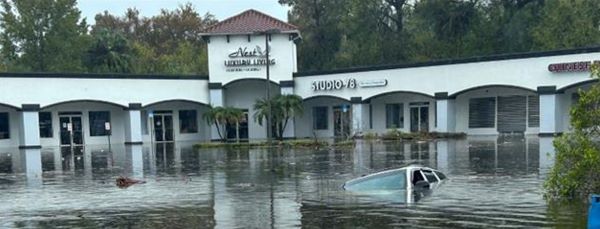
In October, just two weeks after Hurricane Helene (see below), Hurricane Milton formed. Although it reached category 5,5 it made a landfall in the Florida peninsula as a category 3 storm, unleashing tornadoes and severe flooding not only in the US but also in the Yucatan Peninsula and the Caribbean.
In a world without climate change, Hurricane Milton would have made landfall as a category 26 storm. Instead, it struck as a category 3 hurricane, with stronger winds and more intense rainfall, causing extensive tornado activity and damaging infrastructure in regions still7 recovering from previous hurricanes. The hurricane dumped as much water as a 1-in-1,000-year8 rainfall event.
Hurricane Milton is now considered one of the costliest9 storms in US history. Florida was the primary region impacted by the hurricane, with 25 deaths10 reported. The hurricane caused substantial economic and insured losses, with costs comparable11 to those of Hurricane Ian (2022). More than 260,000 people12 had their water supplies contaminated, while nearly 2 million13 were left without power. Nearly 100,000 people14 used shelters during the hurricane.
Climate change significantly exacerbated the impacts of the event. A rapid analysis15 by Climate Central showed that the unusually warm ocean temperatures, which fuelled the hurricane’s rapid intensification, were made 400-800 times more likely by climate change over the two weeks preceding the storm. Similarly, WWA used historical weather observations to estimate16 that similar storms are now twice as likely and bring 20-30% more rainfall due to climate change.
Hurricane Helene
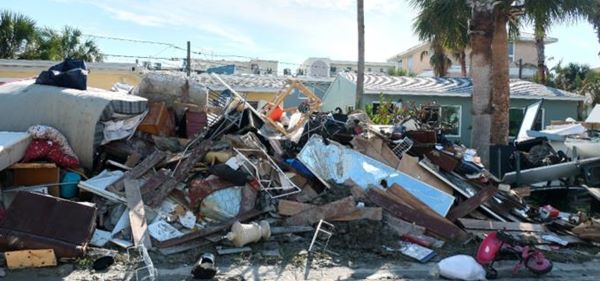
In September 2024, Hurricane Helene made landfall17 in Florida as a powerful Category 4 storm, bringing torrential rainfall, destructive winds, and severe storm surges. As it moved north-northeast, it caused record-breaking rainfall across Georgia, North and South Carolina, Tennessee, and Virginia, as well as destruction in Mexico and Cuba.18 The hurricane triggered flash floods that devastated the region, creating a path of destruction over 600 miles19 long from Florida to Tennessee.
As the rain saturated soils and turned peaceful streams into destructive rivers, entire towns, neighbourhoods, and roads were washed out.20 The hurricane left at least 232 people21 dead – the highest mainland US hurricane death toll since Hurricane Katrina in 2005. In the aftermath of the storm, over 4.7 million people22 were left without power, and thousands went without access to water23 for weeks. Over 11,400 households24 were housed in temporary units.
The federal government provided over $860 million25 in assistance to survivors and spent $137 million26 in recovery efforts. The estimated damage of the hurricane, based on insurance-related assessments, is at up to $55 billion.27 However, while such insurance-based estimates tend to be relatively high in the US compared to other countries they may not fully capture the broader social and economic impact of the storm.
Climate change is making hurricanes more intense. A study28 by WWA found that climate change made the storm about twice as likely, increased rainfall by 20-30% and made wind speeds around 10% stronger. Another analysis29 by Climameter also found the fingerprints of climate change in the event, estimating that global warming increased rainfall by up to 20% and wind by around 7%.
China Floods
Throughout June and July, the southern and central regions of China suffered the impact of extreme rainfall.
In June, the provinces of Guangdong, Guangxi and Fujian saw record downpours that caused floods and landslides.30 Tens of thousands of people had to be evacuated and at least 5 people died.31 The event happened just two months after Guangdong was hit by similar extreme rainfall earlier that caused four deaths.32 Overall, more than 300 people died across the country.
More rivers flooded33 in China this year than in any other year. In July, Henan, Hunan, Hubei, Sichuan, Shaanxi, Gansu and other provinces were also hit by record rainfall.34 In Hunan, a breach in a dike35 caused large-scale flooding and at least 6,000 had to be evacuated. At least 33 weather stations36 had their precipitation records broken. Results of the rainfall included swollen rivers, breaches in major dams, and the soaking of over 2 million hectares of crop area. Local authorities declared a “wartime” emergency due to the severe flooding, with the central government37 issuing over $100 million in immediate disaster reliefs.
Climate change is making downpours more frequent and intense.38 As the planet warms, the atmosphere can hold more moisture and cause heavy rainfall episodes that can lead to floods and landslides.
Typhoon Yagi

Asia’s biggest typhoon of 2024, Super Typhoon Yagi (also known as Enteng), struck multiple countries in Southeast Asia in early September. It triggered39 destructive landslides, severe flooding, and widespread infrastructural damage, particularly in the Philippines, Laos, Vietnam, Myanmar, and Thailand. Equivalent to a Category 540 hurricane, the typhoon reached peak wind speeds exceeding 200 km/h.
In Vietnam,41 Typhoon Yagi affected 26 provinces, destroying thousands of homes and key manufacturing hubs. In Myanmar,42 it was considered one of the worst storms in recent history, devastating entire villages and destroying over 2.3 million hectares43 of agricultural land. In Laos,44 the storm severely damaged 77 schools and 11 health facilities. In Thailand,45 flash flooding and the overflow of major rivers threatened multiple regions. Meanwhile in the Philippines,46 there were 228 reports of flooding that affected over half a million people. Across all affected countries, the death toll exceeded 800,47 with many still reported missing.
The typhoon became the costliest event on record in Vietnam, causing over $3.3 billion48 in damages and leaving thousands of households burdened with debt.49 Total losses across Southeast Asia reached $12.6 billion,50 as the storm caused extensive damage on homes, factories, and critical infrastructure.
The warming of the surface ocean by climate change intensifies tropical cyclones. A rapid analysis51 by Climameter concluded that climate change fuelled the winds and rainfall from the typhoon, increasing their intensity by up to 5% and 20%, respectively.
Hurricane Beryl
Weeks before Hurricane Beryl made landfall, Caribbean Island nations52 were already bracing for its impacts, preparing for outages, road blockages, and shortages of water and food. When the hurricane hit, it was classified as the earliest category 553 storm on record, with winds powerful enough to blow away entire buildings and power lines.
Hurricane Beryl left a path of destruction across the Caribbean before reaching the US, where it brought additional storm surges and flash flooding. By the time it reached Texas, it was weakened to a category 154 hurricane. In total, 70 lives were lost as a result of the storm.
The hurricane caused extensive damage, severely impacting at least 70%55 of buildings on the islands of Carriacou and Petit Martinique. In Jamaica, the hurricane significantly damaged 82 health facilities56 and affected 160,000 people, with 1,876 evacuated to shelters. 60% of the population was left with no electricity57 for up to 8 weeks. In the US,58 about 1.5 million people were left without power two days after landfall, as power lines and infrastructure were heavily damaged.
A rapid analysis59 by Climameter concluded that climate change fuelled the winds and rainfall from the hurricane, increasing their intensity by up to 5% and 30%, respectively. Another study by Climate Central60 found that the storm developed and intensified over unusually warm ocean temperatures, which were made up to 400 times more likely by climate change. Such conditions intensified the hurricane.
Storm Boris
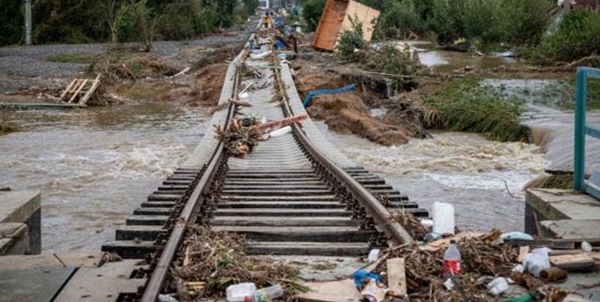
Between 12 and 16 September, Storm Boris hit several countries in central and eastern Europe. During those days, massive amounts of rain fell across Austria, the Czech Republic, Germany, Hungary, Italy, Poland, Romania and Slovakia.
Many locations saw in a few days the same amount of rain as they usually see for the whole month of September. The flooding was described as the ‘worst in two decades’.61 The storm destroyed railways and roads. Firefighters carried out over 500 rescue operations in Italy alone. The floods killed at least 26 people.62
Rapid analyses by WWA and Climameter, published immediately after the event, found fingerprints of climate change in the event. According to WWA,63 four-day rainfall events similar to this one have become about twice as likely and 10% more intense due to human-induced climate change. Similarly, Climameter found that storms such as Boris bring today up to 20% more rainfall than they did at the beginning of the century.
A peer-reviewed study64 published in November estimated that climate change increased the rainfall 9% and expanded the area impacted by extreme rainfall (i.e. higher than 100 mm) by 18%.
Rio Grande do Sul Floods
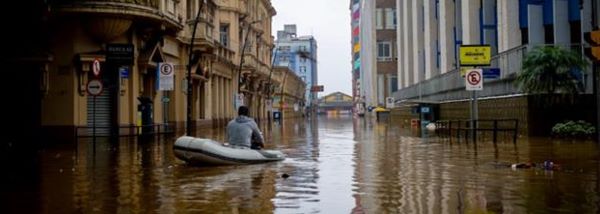
Between late April and mid-May, the state of Rio Grande do Sul in Brazil experienced record rainfall, measuring three times higher65 than the average for this time of the year. Nearly half66 of all the state capital’s neighbourhoods were flooded. The state governor, Eduardo Leite, called the extreme weather event the “worst disaster” in the state’s history.
At least 440 out of the 496 municipalities reported flood-related issues,67 affecting more than 2 million people and displacing approximately 422,000 individuals. A total of 183 people died68 because of the flooding, and another 806 were injured. Essential services were disrupted, infrastructure was damaged and over 100,000 homes69 were destroyed by the floods.
Economists compared the disaster’s impacts to those of 2005 Hurricane Katrina in 2005. Estimates suggest that the flooding caused damages exceeding $2 billion70 to homes, businesses, and infrastructure. The agricultural sector, a central component of Rio Grande do Sul’s economy, suffered significant losses, with the destruction of livestock and crops resulting in approximately $600 million.71 Recovering soil’s lost fertility will cost around $3 billion.72 Other recovery and rebuilding efforts are expected to cost over $550 million,73 placing a heavy financial burden on local and federal governments.
Since the 1960s, the number of days with extreme rainfall has doubled74 in the region. Climate change made this extreme rainfall event twice as likely,75 according to a study from WWA. The same study found that the event was 6-9% more intense due to the burning of fossil fuels. Another analysis76 by Climameter estimated that climate change made the rainfall up to 15% more intense.
Bavaria and Baden-Wurttemberg Floods
Exceptional rainfall resulted in widespread flooding in southern Germany in early June. Water level exceeded historic highs, prompting a state of emergency77 in 18 Bavarian districts. Meteorologists estimated78 that some regions received more rainfall within 24 hours than their normal monthly average.
Multiple rivers broke their banks in Bavaria and Baden-Wurttemberg, prompting evacuations amidst the dam failures and damage to transport networks.79 The floods led to 6 fatalities.80
Insurance companies registered one of the most significant industry losses since 2002, noting that “the three wettest Mays on record for Germany have occurred” in this century. Total damages were estimated at $4.45 billion.81
Germany’s annual temperature has been rising due to climate change, with warmer air holding more moisture and leading to heavier rainfall. Analysis by Climameter82 found that climate change made the event up to 10% wetter. This increase is particularly impactful because the risks associated with rainfall are not linear – a relatively small rise in rainfall can push an event from manageable levels to a catastrophic one, with severe implications for flooding and infrastructure.
Valencia Floods

On 29 October, a meteorological event known as a ‘cut-off low’ brought large amounts of rain to southeast Spain. These types of events, which occur seasonally in the region, are driven by easterly winds that carry humid air from the Mediterranean Sea. The heavy downpours, which in some locations brought the equivalent to one year’s worth of rain83 in just a few hours, caused extensive flooding. The province of Valencia was the most impacted, with devastated cities and a death toll of 218 people. Another 8 deaths were reported in the provinces of Castilla La Mancha and Andalucía.
According to an analysis84 of weather observations by WWA, climate change made the event twice as likely and the rainfall about 12% more intense. The results are in line with another study,85 conducted by Climameter, that found that climate change played a role in fuelling the event, increasing rainfall up to 15%.
Warm sea surface temperatures fuel storms,86 as warm waters create moisture in the air and can lead to stronger events. A third analysis,87 this one by Climate Central, found that around the time of the event, the elevated sea surface temperatures that fuelled the storm that caused the Valencia floods were made 50-300 times more likely by human-caused climate change.
Other Notable Climate Disasters of 2024
Overview
Climate change affects the world in different ways, with many of the most harmful impacts not registering on the top 10 list for economic damage. Here we list 10 other notable disasters that may not have received the same headlines but are devasting lives around the world.
Whilst the growing accuracy and use of science to demonstrate the links between weather events and climate change are becoming more assured, particularly through the work of the World Weather Attribution Group, there are more data gaps than might be expected when it comes to tracking the full extent of economic losses in many global south countries.
Even where data is available, it is hard to compare across contexts and different kinds of disasters. For example, the start and end point of slow onset disasters such as heatwaves may complicate who is counted as being affected as well as what subset of the population is affected.
As in previous years, the mainstay of economic loss estimates is insurance claims or insurance-based estimates, particularly in contexts where there are significant insurance markets. There are seldom equivalent insurance-based ‘economic loss’ estimates in lower income counties because insurance markets are less developed. Therefore, economic loss estimates often rely more on official government or international organisation estimates. These may measure slightly different things compared to insurers, making comparisons harder.
Despite scouring a range of sources, it is noticeable how few climate-related disasters have comprehensive estimates of economic damage in the absence of insurance-based estimates. This is particularly the case for climate disasters in lower-income countries, and especially for slower-onset or more prolonged disasters such as droughts and heatwaves.
For most of these disasters, there is no estimate of the overall economic cost and where there are some economic assessments of impact, they tend to be narrow (e.g., focused on the foregone revenue from a failed harvest of a particular crop) or cover only part of the time period of a disaster. In some cases, the only relevant economic data related to impacts is from UN appeals to partially address the impacts of a crisis. Whilst the ‘uncounted’ deaths of rapid-onset disasters are becoming more recognised, with studies aimed at understanding the long-term increase in fatalities after a natural disaster,88 there is not yet an equivalent way to assess the longer-term economic impacts of disasters at the household, affected population or national levels.
Philippines: Landslides (January – February)
In a corner of Mindanao, a deadly landslide occurred in late January and early February. As a result of a monsoon and two tropical cyclones, a landslide centred in Sitio Panlaisan village killed 22 people and affected more than a million. The International Disaster Database (EMDAT – our source for default ‘price tags’ where data is available) estimates 1.5 million in total were affected – with around 65,000 displaced initially.89 The number of displaced rose quickly after the initial landslide with almost 400,000 by 8 February. Due to heavy rains, some government services and school classes were halted.90 The heavy rains associated with the monsoon and the tropical cyclones are not in themselves unusual in Mindanao but the intensity of such events is apparently increasing, including later cyclones in 2024.
On the evening of February 6, another fatal landslide occurred in a different part of Mindanao Island The landslide happened in the village of Masara following days of heavy rain.91 Almost 100 people were killed in the landslide, and thousands had to be evacuated.92 EMDAT puts the figure of the total number of people affected at 1.4 million. Automatic sensors for collecting data on rainfall and stream levels have not been working since 2022, and whilst early warnings are issued, they do not have sufficient granularity to be very useful. This helps to explain the severe impacts – including deaths and injuries – as well as the wider impacts affecting many people in the area.
Government estimates for the damage caused by the Masara landslide, published less than three weeks after the landslide, give the total cost at the time to be 3.6 billion Philippine pesos, equivalent to around $63 million. Around three-quarters of this was identified as infrastructure costs, given the damage to 278 pieces of infrastructure as well as to around 5,000 houses. Most of the remaining cost was estimated to be for damage to agriculture, with a little earmarked for livestock, poultry, and fisheries.93 This estimate is unlikely to include all economic costs associated with the full impact of the landslide and floods, including foregone revenue because of people not being able to earn a salary or conduct their business as usual. Similarly, the economic effects of schools being closed, and some government services being halted are unlikely to be considered. Therefore, there is a high probability that the figure is an underestimate.
Southern Africa: Drought (February – July)
While the drought impacted multiple countries across southern Africa, the illustrative analysis in this paper will focus on Zambia.
President Hakainde Hichilema declared the drought in Zambia a national emergency on 29 February, the worst drought in living memory.94 The 2023-24 rainy season was affected by El Nino, resulting in reduced rainfall which in early 2024 became a drought. Most of the central and southern parts of the country have been affected. Critical shortages of food were reported in different parts of the country, and harvests were much reduced. For example, cereal production was estimated to fall by 50%,95 in a country heavily reliant on agriculture. The EMDAT data suggests that around 6.6 million people were directly affected between February and July, but it is likely that even more people were directly and indirectly affected, with estimates including 9 million affected by poorer crops. Even before the drought, over 2 million people were food insecure; the drought has exacerbated agriculture production and incomes for many households in a low-income country. The drought has also worsened access to clean water and increasing the risk of waterborne diseases. Over 21,000 suffered cholera with 700 people dying from it.96
The central EMDAT estimate of the economic impact of the drought in Zambia is $228m. This, however, is likely to be a significant underestimate of the economic impact. Inflation has risen whilst availability of food and safe water has been reduced. Wider analysis estimates much higher economic impacts of the drought. For example, a significant reduction in the maize crop is estimated to cost $737 million alone and cattle farmers have potentially incurred a loss of $2.4bn. Together these two estimates are ten times the EMDAT central estimate, which would lead to a per capita loss – if averaged out across affected individuals evenly – of $350 or around a quarter of an annual Zambian average income. These kinds of estimates associated with agricultural losses begin to show the multi-dimensional economic impacts of a prolonged climate-related disaster such as drought in a low-income country like Zambia where agriculture is a key source of food and incomes.
As stated above, the drought has also affected other neighbouring countries in southern Africa such as Zimbabwe, Malawi and Namibia. EMDAT estimates 6.1 million people have been affected in Malawi and 1.6 million in Namibia. Confronting what has been described as the worst drought in a century across the region97 will have lasting economic and social impacts beyond a return to more expected wealth and climate conditions.
Afghanistan/Pakistan: Floods (March – September)

Since March unseasonably heavy rains and flash flooding have killed more than a thousand people and displaced many more across Afghanistan and Pakistan. The unexpected precipitation followed a very dry winter which meant the parched soils were not able to absorb the levels of water, which led to further flooding. This was compounded by unseasonably warm temperatures which further complicated the situation by melting mountain snow, causing rivers to overflow and inundating villages with mud.
In May Hsiao-Wei Lee, Afghanistan’s Country Director for the World Food Programme, said: “With one disaster after another hitting these communities, they’re being pushed back into destitution. Recent improvements in food security in Afghanistan now risk being lost. These families need emergency assistance to survive, and in the longer term, they need investments in community infrastructure that help protect their homes, lands, and livelihoods.”
Afghanistan is ranked seventh98 on the Notre Dame Global Adaptation Index of countries most vulnerable and least prepared to adapt to climate change. Its population faces a ferocious combination of floods, droughts, cold and heatwaves which all affect food insecurity. The population also faces issues of conflict and gender segregation. Considering it has one of the lowest carbon emissions per capita, the scale of the consequences it faces is a tragic injustice.
Afghanistan was not invited to 2023’s COP28 summit in Dubai as the UN doesn’t recognize its government, although it was given observer status to attend this year’s COP29 in Baku, Azerbaijan.
Colombia: Drought (All Year)
Severe drought has seen Amazon River levels in Colombia reduced by up to 90% this year, with Indigenous people bearing the brunt as they rely on the river (the world’s biggest by volume) for food and transport.99
The capital Bogota saw extreme water rationing introduced with couples urged to shower together and whole neighborhoods cut off from the water grid to preserve the little remaining water supplies. Around 70% of the capital’s water comes from the Chingaza reservoir, but its supplies were down to 16% in April100 – their lowest level since 1980. Bogota normally receives twice the amount of rainfall as London but the drought, aggravated by this year’s El Nino effect, has seen the capital surrounded by wildfires.
Unicef estimated101 that 420,000 children were being affected by water scarcity in Colombia, Brazil and Peru, with essential services, including health, education, and child protection, as well as agriculture and fishing livelihoods, severely disrupted. In low water levels in the Colombian Amazon led to restricted access to drinking water and food supplies, and the suspension of in-person classes for children at more than 130 schools. In turn, this increased children’s risk of recruitment, use and exploitation by non-state armed groups, and has also led to increased respiratory infections, diarrheal diseases, malaria, and acute malnutrition among children under age 5. UNICEF Executive Director Catherine Russell said: “We must mitigate the effects of extreme climate crises to protect children today and future generations. The health of the Amazon affects the health of us all.”
United Arab Emirates: Floods (April)
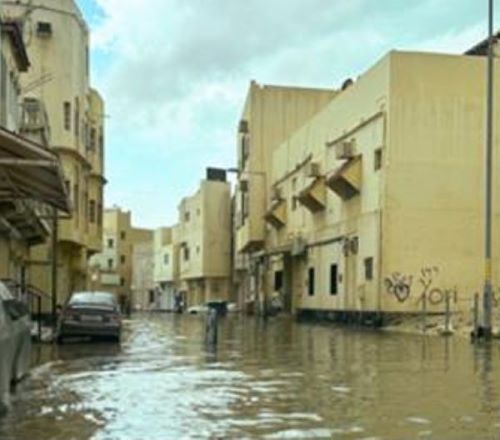
In April, Dubai, which had hosted the COP28 climate talks only six months earlier, received a year and a half worth of rainfall (14cm) in a single day. The deluge was 17 times the monthly average for April of around 8mm. The record rainfall struck countries across the Persian Gulf, killing 20 in Oman, including 10 children after their school bus was washed away. Within days, hospitals in the UAE city of Sharjah grappled with health concerns from stagnant water contaminated with sewage. There were reports of individuals falling sick and children vomiting, prompting the need for urgent medical attention.102
A study by scientists from World Weather Attribution103 found that the extreme event was 1040% more intense than it would have been had it occurred without human induced climate change. Other human caused factors such as widespread urbanisation, inadequate drainage and hyper-arid souls also made the situation worse, exacerbating the risk and severity of flash floods.
Gaza: Heatwave (April)
2024 is projected to be the hottest year on record and April saw a devastating heatwave compound the humanitarian crisis in Gaza. Temperatures spiked above 40C and according to a World Weather Attribution study,104 the heatwave was made five times more likely due to human-caused climate change. They found that the El Nino phenomenon had no impact on the severity of the heatwave in Gaza.
Climate change is a threat multiplier and often impacts people already vulnerable the most. This was the case in Gaza, where 1.7 million displaced people were living outside, crammed into makeshift tents or shelters often with just plastic sheets for cover, making it hotter inside the shelters than outside. The majority of these people were already struggling with insufficient water access and inadequate healthcare. The World Weather Attribution study points out that heatwaves are arguably the deadliest type of extreme weather event with the death toll often underreported. UNRWA, the UN relief agency for Palestinians, said the heat also affected the delivery of aid, with heat-related injuries to staff reported.105
Bangladesh: Heatwave (April – May)
Bangladesh experiences frequent climate-related disasters from cyclones and other storms to floods and sea-level rises. Yet this year saw another kind of climate disaster – a prolonged and intense heatwave in April into May. Despite dealing with multiple climate impacts, the government does not yet have a mechanism to declare an emergency – and thus trigger certain policies and payments – in the event of a heatwave.106 EMDAT estimates that between 21 April and 7 May 33 million of Bangladesh’s 174 million population were affected by a severe heatwave. On 24 April, a severe heatwave (at least 40°C) was registered in the districts of Rajshahi, Pabna, Khulna, Bagerhat, Jeshore and Patuakhali. On 26 April, an all-time heatwave record was set as the Bangladesh Meteorological Department recorded 24 days of a heatwave during the month of April, breaching the previous 23 days of a heatwave in 2019. The estimate of 33 million people affected is based on just the number of children who missed education since schools were closed due to the heat;107 it is therefore likely that many millions more were affected directly by the heatwaves.
Bangladesh is one of the country’s most vulnerable to growing climate change impacts.108 The true human and economic impacts of heatwaves like the one experienced in April and May are hard to quantify. There are often no clearly defined start and end points. Similarly, the precise numbers of people affected can be hard to estimate and the exact nature of the impacts of slower onset disasters such as heatwaves, particularly the economic costs, can be difficult to determine. This tends to lead to under-estimating the economic costs since only directly attributable costs are considered, whereas the knock-on economic consequences of heatwaves may be very large. For example, one academic study found that the combined economic impacts from extreme heat and flooding in Bangladesh’s primary export sector of ready-made garments could total $27bn by 2030 without adaptive practices being adopted.109
East Antarctic: Heatwave (July)
In July, the middle of the Antarctic winter, temperatures rose 28C above expectations on some days, the second heatwave to hit the polar region in the last two years. Last year saw a record low in terms of sea ice around Antarctica which could be accelerating the warming. Sea ice reflects heat back into space, so when ice is replaced by water, more heat is absorbed. 2024 has also seen temperature records broken around the world and it is likely to be the hottest year on record. Polar regions heat up twice as fast as the global average.110
At the time Jamin Greenbaum, a geophysicist at the University of California San Diego’s Scripps Institution of Oceanography, said he was “certainly worried about what’s in store for this region in the years to come. The majority of my field expeditions have been to East Antarctica where I have seen increasing melt through the years,” he said. “Although I’m of course alarmed to see these reports of the weakened polar vortex causing the tremendous heatwave there, I’m also not surprised considering this is sadly an expected outcome of climate change.111
West Africa: Floods (August-September)
Torrential rains in West Africa affected112 6.6 million people, an increase of 40% on the previous year according to the UN Office for the Coordination of Humanitarian Affairs (OCHA). Chad, Nigeria and Niger were the worst affected with livelihoods wrecked and access to services disrupted. Across the region more than 2000 people were killed, a million were displaced, more than 600,000 homes were destroyed and 720,000 hectares of land for agriculture and livestock production was affected.
Scientists from the World Weather Attribution study113 found that human-induced climate change doubled the likelihood of these floods. They said that under a future heating scenario where the global temperature is 2°C higher than pre-industrial levels, climate models suggest that even wetter 30-day periods should be expected. This means they will be common occurrences, and the region needs to prepare for even heavier events than those observed in 2024.
Those suffering these impacts are some of the poorest and most vulnerable in the world and also contribute the least to causing the climate crisis. At the time Joyce Kimutai, researcher at the Centre for Environmental Policy at Imperial College in London, said: “Africa has contributed a tiny amount of carbon emissions globally but is being hit the hardest by extreme weather.” According to the Notre Dame Climate Vulnerability Index114 Chad is the most vulnerable and least prepared nation on the planet, ranking 187th out of 187. Other countries impacted by the flooding are Mali, ranked 180th and Niger, ranked 176th.
Mayotte: Cyclone Chido (December)
On December 14 Cyclone Chido struck the main island of Mayotte in the India Ocean. The worst storm in 90 years to hit the archipelago, windspeeds of 140mph flattened some of the poorest areas where many people live in homes made of wood and metal sheets. The large number of undocumented migrants in the population of 320,000 has made it hard to estimate the number of fatalities, but Mayotte’s prefect, François-Xavier Bieuville told media the casualties “will certainly be several hundreds, maybe we will reach a thousand, even several thousands.” He added that with many of the residents of the French overseas territory being Muslim, the custom of burying the dead within 24 hours means it will not be possible to determine the exact number killed by the storm. One resident, Mohamed Ishmael, who lives in the capital, Mamoudzou, told115 the Reuters news agency: “You feel like you are in the aftermath of a nuclear war… I saw an entire neighbourhood disappear.” Cyclone Chido also struck parts of neighbouring East Africa, with early reports116 stating that it had killed at least 34 people in Mozambique and affected 174,000.
A study by Imperial College London found that human-caused climate change intensified Cyclone Chido’s destructive winds, elevating it from a category 3 to a category 4 storm when it struck Mayotte. The hot sea temperatures that provided the fuel for Chido to form and rapidly intensify were also made more than 50 times more likely by climate change.117
Professor Liz Stephens from the University of Reading, said:118 “The intensity of tropical cyclones in the South West Indian Ocean has been increasing, this is consistent with what scientists expect in a changing climate – warmer oceans fuel more powerful storms. Even though the path of Cyclone Chido was well forecasted several days ahead, communities on small islands like Mayotte don’t have the option to evacuate – there’s nowhere to go.
“The tragic impacts of Cyclone Chido in Mayotte really show how vulnerable small islands are to climate change. A single storm can severely damage critical infrastructure like power, water supply and communications across an entire island, making international support essential. Small islands must be supported to build resilience to tropical cyclones. It is not enough to just improve early warning systems, we must improve the resilience of homes and critical infrastructure to ensure that people have somewhere safe to shelter and essential services are operational during and after the storm.”
Recommendations
- As countries submit their Nationally Determined Contributions (NDCs) in 2025, we need to see far more rapid carbon emissions cuts from rich, polluting nations. These developed countries need to heed the warning from the International Energy Agency, and the COP28 agreement in Dubai, and stop developing all new fossil fuel projects and divert the trillions of dollars of subsidies to supporting an energy transition and to climate adaptation both domestically and internationally.
- The process of submitting NDCs should also ensure the funding gaps faced by lower income countries are bridged so that they can mitigate and address climate impacts. The New Collective Quantified Goal (NCQG) agreed at COP29 fell far short of providing the finance that is needed. In 2025 wealthy nations need to agree new forms of public finance, such as polluter-pay and extreme wealth taxes, to provide the $1.3tn annual finance needed for the NCQG.
- The new Fund for Responding to Loss and Damage is now operational. But it is critically low in funding with under $1bn committed so far. As well as a big funding boost it needs to demonstrate it can respond quickly and effectively to climate impacts which can’t be adapted to.
- The unequal impact of climate disasters demonstrates the importance of adaptation to lower vulnerability before disasters strike. Whilst much progress has been made in reducing the incidence of deaths, much more can be done to make communities more resilient, for example by investing in agroecology which can withstand climate change better whilst helping to prevent emissions in the first place. This should form a key part of the Global Goal on Adaptation which is due to be agreed in 2025.
- The global ‘postcode lottery’ facing those experiencing climate disasters shows the importance of governments investing in effective social protection. These services are even more vital when homes and livelihoods have been damaged and can help people recover dignity and agency as well as practically providing income and wider economic benefits. Rich countries have a vital role to ensure lower income country governments have more ‘fiscal space’ to invest in social protection, through debt relief, fairer international tax rules, mobilising international climate finance and development aid.
- The patchy data on the impacts of climate-related disasters in the global south highlights the importance of better data provision and gathering. It is particularly important to understand the totality of economic impacts in lower income countries where insurance-based estimates are not often available.
- Researchers should develop methodologies for analysing the long-term impacts of climaterelated disasters, including economic costs, so that a more comprehensive understanding of prevention, adaptation and addressing losses is produced. This can contribute to a more needsbased approach to international climate finance.
Endnotes
- aon-q3-2024-global-catastropherecap.pdf
- May Severe Outbreak Spawned Over 165 Tornadoes | Weather.com
- Winter Storm Sage: Northeast, New England Begin To Dig Out | Weather Underground
- Power outages in Capital Region top 100K | News10
- Hurricane Milton explodes into a powerful Category 5 storm as it heads for Florida − here’s how rapid intensification works | The Conversation
- Yet another hurricane wetter, windier and more destructive because of climate change | World Weather Attribution
- Hurricane Milton, Helene live updates: Death toll, flooding, power outages | Vox
- Hurricane Milton dropped 1-in-1,000year levels of rain around Tampa Bay | NBC News
- Hurricane Milton’s losses of up to $34 billion could make it one of the costliest storms in US history | CNN Business
- Hurricane Milton deaths in Florida up to 25 with Charlotte County man | The Palm Beach Post
- Hurricane Milton could cost insurers up to $100 billion, analysts say | Reuters
- https://www.ft.com/content/45b256e5d41d-4203-b0f1-455d8c42bf7b
- Hurricane Milton aftermath: 17 dead as Florida power outages, flooding persist | NBC News
- Hurricane Milton aftermath as families reveal how they survived – as it happened | News US | Metro News
- Analysis: Ocean temperatures warmed by climate change provided fuel for Hurricane Milton’s extreme rapid intensification | Climate Central
- Yet another hurricane wetter, windier and more destructive because of climate change | World Weather Attribution
- #Helene resources: The latest storm forecasts, maps, imagery and more | National Oceanic and Atmospheric Administration
- Cuba under hurricane watch as tropical storm Helene brushes past island | AP News
- Hurricane Helene: Mapping More Than 600 Miles of Devastation | The New York Times
- Hurricane Helene’s extreme rainfall and catastrophic inland flooding | NOAA Climate.gov
- Helene updates: Death toll rises to at least 227 | CNN
- Hurricane Helene causes over 4.7 million power outages across Southeast US | S&P Global
- Hurricane Helene leaves thousands without clean water in its wake | Hurricane Helene | The Guardian
- One Month After Hurricane Helene, Recovery Continues | FEMA.gov
- https://www.fema.gov/pressrelease/20241014/biden-harrisadministration-provides-860-millionhurricane-helene-and-milton
- Hurricane Helene updates: Death toll surpasses 230 as rescue efforts continue | ABC News
- https://www.bloomberg.com/news/articl es/2024-10-14/helene-milton-seencosting-insurers-as-much-as-55-billion
- Climate change key driver of catastrophic impacts of Hurricane Helene that devastated both coastal and inland communities | World Weather Attribution
- ClimaMeter – 2024/09/26-27 Hurricane Helene
- https://www.reuters.com/world/china/fo ur-killed-landslides-heavy-rain-lasheschinas-fujian-2024-06-17/
- Heavy rains, landslides in China’s Guangdong and Fujian kill nine | Reuters
- China evacuates over 100,000 as heavy rain continues to lash south | Climate Crisis News | Al Jazeera
- Record flooding seen in China’s major rivers | Chinadaily.com.cn
- https://www.reuters.com/world/china/c hinas-rains-floods-led-near-doublingnatural-disaster-losses-july-2024-08-09/
- https://erccportal.jrc.ec.europa.eu/ECH O-Products/Echo-Flash#/daily-flasharchive/5110
- Extreme Weather Cost China More Than $10 Billion In July Alone | Asia Financial
- China Briefing 11 July 2024: ‘Wartime’ flooding emergency; EU tariff impact; Record-low coal share | Carbon Brief
- Heavy downpours more intense, frequent in a warmer world | NOAA Climate.gov
- Super Typhoon Yagi causes severe flooding across Southeast Asia | IFRC
- https://www.euronews.com/green/2024/ 09/11/typhoon-yagi-is-the-strongeststorm-in-asia-this-year-is-climatechange-to-blame
- Super Typhoon Yagi causes severe flooding across Southeast Asia | IFRC
- Typhoon Yagi: Myanmar floods death toll doubles to 226 | BBC News
- Urgent action required to tackle ongoing humanitarian crisis in Myanmar after Typhoon Yagi | IFRC
- UNICEF Lao (PDR) Humanitarian Situation Report No. 2 (Super Typhoon Yagi): 26 September 2024 – Lao People’s Democratic Republic (the) | ReliefWeb
- Super Typhoon Yagi still leaves huge impact in northern Thailand and Myanmar although it downgrades to low-pressure area | Bangkok Tribune
- Super Typhoon Yagi still leaves huge impact in northern Thailand and Myanmar although it downgrades to low-pressure area | Bangkok Tribune
- Typhoon Yagi – Sep 2024 | ReliefWeb
- Vietnam estimates damages of $3.31 bln from Typhoon Yagi | Reuters
- https://vietnamnet.vn/en/typhoonyagi-leaves-well-off-households-emptyhanded-crippled-by-debt-2327527.html
- aon-q3-2024-global-catastropherecap.pdf
- ClimaMeter – 2024/09/07-08 Typhoon Yagi
- Hurricane Beryl: For hard-hit islands, preparation paid off with rapid response. But recovery is complicated by widespread damage. | IFRC
- Hurricane Beryl charges toward Jamaica as record-breaking Category 5 after leaving Caribbean islands in ruins | CNN
- Hurricane Beryl’s trail of destruction in photos | AP News
- Hurricane Beryl: Update #3 | 12 July 2024 – Grenada | ReliefWeb
- Months After Hurricane Beryl, Rebuilding in the Caribbean | CARE
- Hurricane Beryl: Jamaica – Situation Report No.2 (As of 13 July 2024) – Jamaica | ReliefWeb
- Damage from Hurricane Beryl may cost insurers $2.7 bln in US, KCC says | Reuters
- ClimaMeter – 2024/09/07-08 Typhoon Yagi
- Hurricane Beryl fueled by ocean warming linked to climate change | Climate Central
- Two missing and 1,000 evacuated as Storm Boris devastates northern Italy | Extreme weather | The Guardian
- https://www.reuters.com/world/europe/ poland-reports-two-more-deathscentral-europe-floods-2024-09-27/
- Climate change and high exposure increased costs and disruption to lives and livelihoods from flooding associated with exceptionally heavy rainfall in Central Europe | World Weather Attribution
- How climate change intensified storm Boris’ extreme rainfall, revealed by nearreal-time storylines | Communications Earth & Environment
- Brazil: Rio Grande do Sul floods | IFRC
- Enchente atingiu 46 bairros e afetou diretamente 157 mil pessoas em Porto Alegre, aponta mapeamento da prefeitura | GZH
- Enchente atingiu 46 bairros e afetou diretamente 157 mil pessoas em Porto Alegre, aponta mapeamento da prefeitura | GZH
- https://www.estado.rs.gov.br/defesacivil-atualiza-balanco-das-enchentes-nors-20-8
- O drama dos desabrigados após enchentes no Rio Grande do Sul | Publica
- Heavy flooding in southern Brazil kills 150 and displaces 600,000 | Financial Times
- Catastrophic Floods in Southern Brazil: Implications for Agricultural Sector | farmdoc daily
- Brazil: Rio Grande do Sul Flood Emergency: Snapshot #3 As of 10 June 2024 – Brazil | ReliefWeb
- sisweb.tesouro.gov.br/apex/f?p=2501:9:: ::9:P9_ID_PUBLICACAO:50825#page=33
- portal.inmet.gov.br/uploads/normais/N ORMAISCLIMATOLOGICAS.pdf
- Climate change, El Niño and infrastructure failures behind massive floods in southern Brazil | World Weather Attribution
- ClimaMeter – 2024/05/02 South Brazil Floods
- https://data.consilium.europa.eu/doc/d ocument/ST-14940-2024-INIT/EN/pdf
- Firefighter killed, ICE train derails as catastrophic flooding continues in southern Germany | Euronews
- Widespread Flooding Disrupts CrossBorder Transport in Germany | Bloomberg
- Death toll from floods across southern Germany rises to 6 | AP News
- aon-q3-2024-global-catastropherecap.pdf
- ClimaMeter – 2024/06/01-03 Southern Germany Floods
- Devastating rainfall hits Spain in yet another flood-related disaster | World Meteorological Association
- Extreme downpours increasing in southeastern Spain as fossil fuel emissions heat the climate | World Weather Attribution
- ClimaMeter – 2024/10/29 South-East Spain Floods
- Fuel for the Storm | Ocean Today
- Analysis: Valencia floods fueled by ocean warming in the Tropical Atlantic linked to climate change | Climate Central
- What is the real toll of natural and climate disasters? Science has staggering new answers | Devi Sridhar | The Guardian
- Philippines: Floods and Landslides – Jan 2024 | ReliefWeb
- More than 1,411 residents in Davao region displaced due to heavy rains OCD | DZRH
- Philippines: Disruptions due to landslide ongoing in Maco Municipality, Davao de Oro Province, as of Feb. 8 | Crisis24
- The 6 February 2024 landslide at Masara in the Philippines | Eos
- Mindanao floods, landslides: Agriculture, infrastructure damage hits P3.6 billion | Philstar.com
- Zambia targets growth rebound after worst drought in living memory | Reuters
- Zambia: Drought Response Appeal May 2024 – December 2024 (May 2024) | United Nations in Zambia
- Zambia: Climate finance for resilience to counter ongoing drought | PreventionWeb
- IMF Staff Completes Mission to Zambia | International Monetary Fund (IMF)
- Rankings // Notre Dame Global Adaptation Initiative // University of Notre Dame
- Drought reduces Amazon River in Colombia by as much as 90%: report | Phys.org
- https://archive.is/JVRxp#selection3423.0-3423.148
- Over 420,000 children affected by record-breaking drought in the Amazon region | UNICEF
- UAE floods: Hospitals, clinics offer free services amid reports of illness – News | Khaleej Times
- Heavy precipitation hitting vulnerable communities in the UAE and Oman becoming an increasing threat as the climate warms | World Weather Attribution
- Climate change made the deadly heatwaves that hit millions of highly vulnerable people across Asia more frequent and extreme | World Weather Attribution
- Gaza heat wave is a glimpse of a tough summer ahead | NPR
- Will Bangladesh declare heatwaves a disaster? | Dhaka Tribune
- Asia and the Pacific: Heatwaves in South and South-East Asia (April 2024) as of 17 May 2024 – Bangladesh | ReliefWeb
- Global Climate Risk Index 2021 – World | ReliefWeb
- Prolonged heatwave hits life, economy | The Business Standard
- The quandary of detecting the signature of climate change in Antarctica | Nature Climate Change
- Antarctic temperatures rise 10C above average in near record heatwave | Antarctica | The Guardian
- West and Central Africa: Flooding Situation Overview – as of 5 October 2024 – Chad | ReliefWeb
- Conflict, poverty and water management issues exposing vulnerable communities in Africa to extreme floods that are now common events because of climate change | World Weather Attribution
- Rankings // Notre Dame Global Adaptation Initiative // University of Notre Dame
- Mayotte: Several hundred feared dead after Cyclone Chido | BBC News
- At least 34 killed by Cyclone Chido in Mozambique, UN agency says | Reuters
- Cyclone Chido: Are European countries throwing their overseas territories to the climate wolves? | Yahoo! News
- Mayotte tropical cyclone expert reaction | University of Reading
Originally published by Christian Aid, December 2024, republished with permission for educational, non-commercial purposes.


